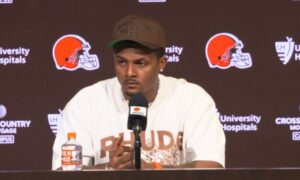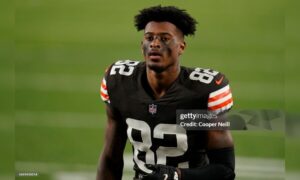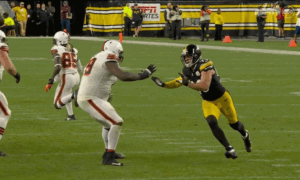The NFL had suspended Pittsburgh Steelers linebacker James Harrison for one game for his helmet-to-helmet hit Thursday night on Cleveland Browns quarterback Colt McCoy according to multiple sources. Harrison hit McCoy in the 4th quarter of the Steelers 14-3 win Thursday night after McCoy scrabbled out of the pocket, tucked the ball underneath his arm and then decided to throw at the last minute while outside the tackle box. Harrison hit McCoy in his facemask with his helmet just after McCoy completed his throwing motion. The hit knocked McCoy off of his feet and he slammed backwards into the ground. McCoy had to leave the game, but returned a few plays later. Harrison was flagged on the play.
The suspension of Harrison is effective immediately and he will not be allowed to practice or be at Steelers practice facility until Dec. 20 when he is reinstated by the league. This is the first suspension for Harrison as the league is taking discipline now against him as a repeat offender after he was fined several times during the 2010 season. There is no word yet on the dollar amount that Harrison was fined. Harrison has 3 days to appeal, and an expedited hearing and decision would take place this week in advance of the Steelers Monday night game against the San Francisco 49ers. Appeals are heard and decided on rotating basis by either Art Shell or Ted Cottrell.
Rule 12, Section 2, Article 9 of the NFL Rule Book states: “It is a foul if a player initiates unnecessary contact against a player who is in a defenseless posture. (a) Players in a defenseless posture are: (1) A player in the act of or just after throwing a pass.
Rule 12, Section 2, Article 13 (8) and (3) is also applicable to the roughing the passer penalty called against Harrison.
When a passer is outside the pocket area, as McCoy was, he is still afforded the protection of Article 13 (3), which prohibits defensive players from using their helmet against a passer who is in a defenseless posture, including by “forcibly hitting the passer’s head or neck area with the helmet or facemask, regardless of whether the defensive player also uses his arms to tackle the passer by encircling or grasping him”.
The applicable rules:
PASSER OUT OF THE POCKET
(8) When the passer goes outside the pocket area and either continues moving with the ball (without attempting to advance the ball as a runner) or throws while on the run, he loses the protection of the one-step rule provided for in (1) above, and the protection against a low hit provided for in (5) above, but he remains covered by all the other special protections afforded to a passer in the pocket (numbers 2, 3, 4, 6, and 7), as well as the regular unnecessary-roughness rules applicable to all player positions. If the passer stops behind the line and clearly establishes a passing posture, he will then be covered by all of the special protections for passers.
HITS TO PASSER’S HEAD AND USE OF HELMET AND FACEMASK
(3) In covering the passer position, Referees will be particularly alert to fouls in which defenders impermissibly use the helmet and/or facemask to hit the passer, or use hands, arms, or other parts of the body to hit the passer forcibly in the head or neck area (see also the other unnecessary-roughness rules covering these subjects). A defensive player must not use his helmet against a passer who is in a defenseless posture for example, (a) forcibly hitting the passer’s head or neck area with the helmet or facemask, regardless of whether the defensive player also uses his arms to tackle the passer by encircling or grasping him, or (b) lowering the head and making forcible contact with the top/crown or forehead/”hairline” parts of the helmet against any part of the passer’s body. This rule does not prohibit incidental contact by the mask or non-crown parts of the helmet in the course of a conventional tackle on a passer.







